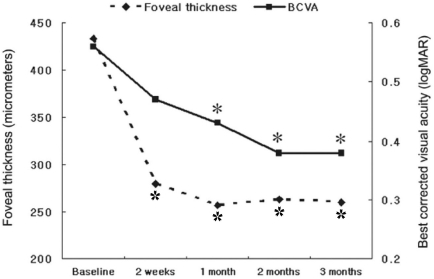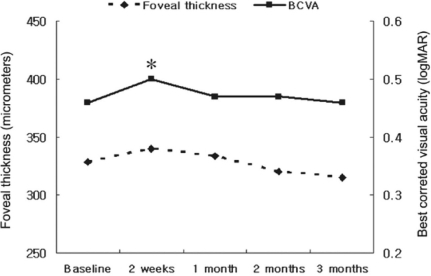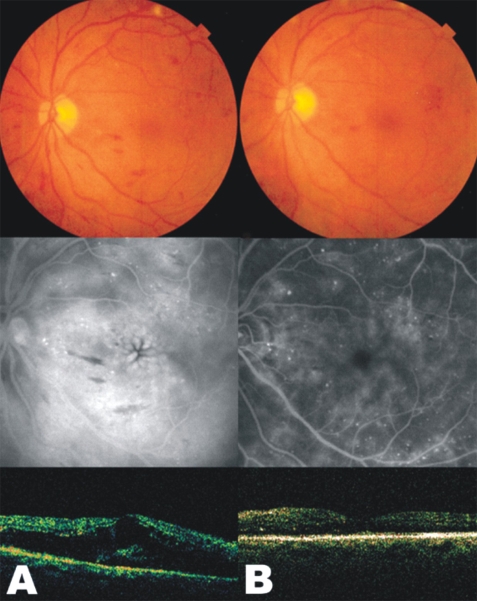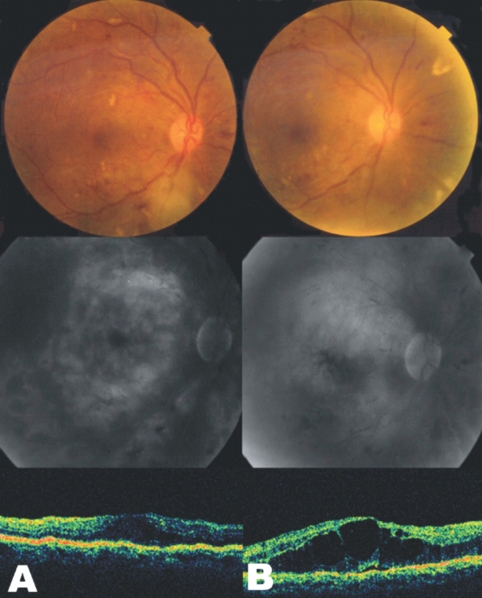Korean J Ophthalmol.
2007 Mar;21(1):11-17. 10.3341/kjo.2007.21.1.11.
Laser Photocoagulation Combined with Intravitreal Triamcinolone Acetonide Injection in Proliferative Diabetic Retinopathy with Macular Edema
- Affiliations
-
- 1Department of Ophthalmology, Soonchunhyang University, College of Medicine, Seoul, Korea. ckseek@naver.com
- KMID: 1105024
- DOI: http://doi.org/10.3341/kjo.2007.21.1.11
Abstract
- PURPOSE: To evaluate therapeutic effects and usefulness of a combination treatment of intravitreal injection of triamcinolone acetonide (IVTA) and panretinal photocoagulation (PRP) in patients with clinically significant macular edema secondary to proliferative diabetic retinopathy (PDR). METHODS: Visual acuity test, fundoscopy, fluorescein angiography, and optical coherence tomography (OCT) were taken in 20 patients (20 eyes) of macular edema and PDR. A combination of intravitreal injection of triamcinolone acetonide and PRP was performed in 10 patients (10 eyes) and a combination of focal or grid laser photocoaqulation and PRP in the remaining 10 eyes. The postoperative outcomes were compared between the two combination treatments by best corrected visual acuity (BCVA), tonometry, fluorescein angiography, and OCT at 2 weeks, 1, 2, and 3 months. RESULTS: Average BCVA (log MAR) significantly improved from preoperative 0.56+/-0.20 to 0.43+/-0.08 at 1 month (P=0.042) and it was maintained until 3 months after a combination of IVTA and PRP in 10 eyes (P=0.007). The thickness of fovea decreased from average 433.3+/-114.9 micrometer to average 279.5+/-34.1 micrometer at 2 weeks after combined treatment of IVTA and PRP (P=0.005), which was significantly maintained until 3 months, but there was a transient visual disturbance and no significant difference in thickness of the fovea before and after treatment in the groups with PRP and focal or grid laser photocoagulation. CONCLUSIONS: A combination of IVTA and PRP might be an effective treatment modality in the treatment of macular edema and PDR and prevent the subsequent PRP-induced macular edema result in visual dysfunction. In combination with PRP, IVTA might be more effective than focal or grid laser photocoagulation and PRP for reducing diabetic macular edema and preventing aggravation of macular edema without transient visual disturbance in patients requiring immediate PRP.
Keyword
MeSH Terms
Figure
Cited by 2 articles
-
Macular Thickness and Visual Acuity Before and After Panretinal Photocoagulation in Severe Diabetic Retinopathy
Sang Hoon Park, Su Jeong Song
J Korean Ophthalmol Soc. 2009;50(5):717-724. doi: 10.3341/jkos.2009.50.5.717.Long-term Effect of Panretinal Photocoagulation Combined With Intravitreal Bevacizumab in High-risk Proliferative Diabetic Retinopathy
Jun Ho Choi, Sung Jin Lee, Kyung Seek Choi
J Korean Ophthalmol Soc. 2010;51(6):842-848. doi: 10.3341/jkos.2010.51.6.842.
Reference
-
1. Aiello LM. Perspectives on diabetic retinopathy. Am J Ophthalmol. 2003; 136:122–135. PMID: 12834680.
Article2. Akduman L, Olk RJ. Laser photocoagulation of diabetic macular edema. Ophthalmic Surg Lasers. 1997; 28:387–408. PMID: 9150523.
Article3. Early Treatment Diabetic Retinopathy Study Research Group. Photocoagulation for diabetic macular edema. Early Treatment Diabetic Retinopathy Study report number 1. Arch Ophthalmol. 1985; 103:1796–1806. PMID: 2866759.4. Early Treatment Diabetic Retinopathy Study Research Group. Treatment techniques and clinical guidelines for photocoagulation of diabetic macular edema. Early Treatment Diabetic Retinopathy Study report number 2. Ophthalmology. 1987; 94:761–774. PMID: 3658348.5. Ferris FL, Podgor MJ, Davis MD. Macular edema in diabetic retinopathy study patients Diabetic Retinopathy Study Group report number 12. Ophthalmology. 1987; 94:754–760. PMID: 3658347.6. Kleiner RC, Elman MJ, Murphy RP, Ferris FL 3rd. Transient severe visual loss after panretinal photocoagulation. Am J Ophthalmol. 1988; 106:298–306. PMID: 3421291.7. Meyers SM. Macular edema after scatter laser photocoagulation for proliferative diabetic retinopathy. Am J Ophthalmol. 1980; 90:210–216. PMID: 6158867.
Article8. Shimura M, Yasuda K, Nakazaya T, et al. Quantifying alterations of macular thickness before and after pan-retinal photocoagulation in patients with severe diabetic retinopathy and good vision. Ophthalmology. 2003; 110:2386–2394. PMID: 14644723.
Article9. Shimura M, Yasuda K, Nakazawa T, Tamai M. Visual Dysfunction After Panretinal Photocoagulation in Patients With Severe Diabetic Retinopathy and Good Vision. Am J Ophthalmol. 2005; 140:8–15. PMID: 15939392.
Article10. Jonas JB, Kreissig I, Sofker A, Degenring RF. Intravitreal injection of triamcinolone for diffuse diabetic macular edema. Arch Ophthalmol. 2003; 121:57–61. PMID: 12523885.
Article11. Martidis A, Duker JS, Greenberg PB, et al. Intravitreal triamcinolone for refractory diabetic macular edema. Am J Ophthalmol. 2002; 109:920–927.
Article12. Jonas JB, Hayler JK, Panda-Jonas S. Intravitreal injection of crystalline cortisone as adjunctive treatment of proliferative vitreoretinopathy. Br J Ophthalmol. 2000; 84:1064–1067. PMID: 10966969.
Article13. Sakamoto T, Miyazaki M, Hisatomi T, et al. Triamcinolone assisted pars plana vitrectomy improves the surgical procedures and decreases the postoperative blood-ocular barrier breakdown. Graefes Arch Clin Exp Ophthalmol. 2002; 240:423–429. PMID: 12107507.14. Bresnick GH. Diabetic macular edema: a review. Ophthalmology. 1986; 93:989–997. PMID: 3531959.15. Diabetic Retinopathy Study Research Group. Diabetic Retinopathy Study. Report 6. Design, methods and baseline results. Invest Ophthalmol Vis Sci. 1981; 21:149–209.16. Stratton IM, Kohner EM, Aldington SJ, et al. UKPDS 50: risk factors for incidence and progression of retinopathy in type II diabetes over 6 years from diagnosis. Diabetologia. 2001; 44:156–163. PMID: 11270671.
Article17. McDonald HR, Schatz H. Macular edema following panretinal photocoagulation. Retina. 1985; 5:5–10. PMID: 4001591.
Article18. McDonald HR, Schatz H. Visual loss following panretinal photocoagulation for proliferative diabetic retinopathy. Ophthalmology. 1985; 92:388–393. PMID: 4039432.
Article19. Higgins KE, Meyers SM, Jaffe MJ, et al. Temporary loss of foveal contrast sensitivity associated with panretinal photocoagulation. Arch Ophthalmol. 1998; 104:997–1003. PMID: 3729795.
Article20. Gardner TW, Eller AW, Friberg TR. Reduction of severe macular edema in eyes with poor vision after panretinal photocoagulation for proliferative diabetic retinopathy. Graefes Arch Clin Exp Ophthalmol. 1991; 229:323–328. PMID: 1916318.
Article21. Aiello LM. Albert DM, Jakobiec FA, editors. Diagnosis, management and treatment of nonproliferative diabetic retinopathy and macular edema. Principles and Practice of Ophthalmology. 2000. v. 3:2nd ed. Philadelphia: WB Saunders;chap. 138.22. Early Treatment Diabetic Retinopathy Study Research Group. Early photocoagulation for diabetic retinopathy. ETDRS report number 9. Ophthalmology. 1991; 98:766–786. PMID: 2062512.23. Jonas JB, Kreissig I, Degenring R. Intraocular pressure after intravitreal injection of triamcinolone acetonide. Br J Ophthalmol. 2003; 87:24–27. PMID: 12488256.
Article24. Jonas JB, Kreissig I, Degenring R. Secondary chronic open angle glaucoma after intravitreal triamcinolone acetonide. Arch Ophthalmol. 2003; 121:729–730. PMID: 12742856.25. Moshfeghi DM, Kaiser PK, Scott IU, et al. Acute endophthalmitis following intravitreal triamcinolone acetonide injection. Am J Ophthalmol. 2003; 136:791–796. PMID: 14597028.
Article26. Antoszyk AN, Gottlieb JL, Machemer R, Hatchel DL. The effects of intravitreal triamcinolone acetonide on experimental pre-retinal neovascularization. Graefe Arch Clin Exp Ophthalmol. 1993; 231:34–40.
Article27. Gillies MC, Simpson JM, Luo W, et al. A randomized clinical trial of a single dose of intravitreal triamcinolone acetonide for neovascular age-related macular degeneration: one-year results. Arch Ophthalmol. 2003; 121:667–673. PMID: 12742844.28. Jonas JB, Hayler JK, Sofker A, Panda-Jonas S. Regression of neovascular iris vessel by intravitreal injection of crystalline cortisol. J Glaucoma. 2001; 10:284–287. PMID: 11558812.
- Full Text Links
- Actions
-
Cited
- CITED
-
- Close
- Share
- Similar articles
-
- Intravitreal Injection of Triamcinolone for Refractory Diabetic Macular Edema
- The Effect of Intravitreal Triamcinolone Acetonide Injection according to the Diabetic Macular Edema Type
- Intravitreal and Additional Posterior Subtenon Triamcinolone Injection in Diabetic Macular Edema
- The Combined Effect of Subtenon Triamcinolone Injection and Panretinal Photocoagulation on Diabetic Retinopathy
- A Case of Central Retinal Artery Occlusion after Intravitreal Triamcinolone Acetonide Injection for Diabetic Macular Edema in Non-Proliferative Diabetic Retinopathy





